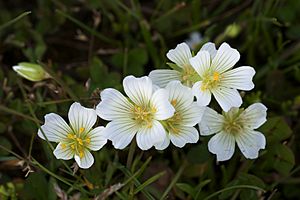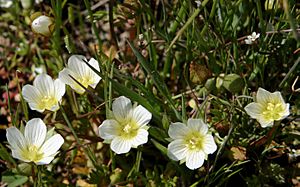Woolly meadowfoam facts for kids
Quick facts for kids Woolly meadowfoam |
|
|---|---|
 |
|
| ssp. californica | |
| Scientific classification | |
| Genus: |
Limnanthes
|
| Species: |
floccosa
|
| Subspecies | |
|
L. floccosa subsp. bellingeriana L. floccosa subsp. californica L. floccosa subsp. floccosa |
|
Limnanthes floccosa, also known as woolly meadowfoam, is a special type of plant. It's a species of meadowfoam that grows in Northern California and Southern Oregon in the United States.
Many types of woolly meadowfoam are quite rare. They are listed as critical or endangered. This means they are at high risk of disappearing forever.
One well-known type is called californica. It's not easy to spot, but it has been part of some important discussions. This type of meadowfoam only grows in a few places in Butte County, California. It is legally protected because it's endangered. Sometimes, people disagree about how to use the land where this plant lives. Some want to protect the plant, while others want to use the land for building or other activities.
Certain types of L. floccosa have been used to make a better kind of meadowfoam crop. This crop is grown for its special seed oil. This oil is used in things like cosmetics because it's very stable and doesn't have a smell. It also makes skin feel soft. Meadowfoam is grown in places like the Willamette Valley in Oregon.
Contents
Understanding Woolly Meadowfoam
Woolly meadowfoam (Limnanthes floccosa) belongs to a group of plants where the petals curve over the fruit when it's ripe. Most of these plants can pollinate themselves. This means they don't always need insects to help them make seeds.
You can tell woolly meadowfoam apart from other similar plants. Its petals are usually not much longer than its sepals (the leaf-like parts that protect the flower bud). The flowers often stay closed even when they are fully grown. This is different from other meadowfoam plants, like the Table Mountain meadowfoam.
Where Does Woolly Meadowfoam Grow?
The most common type of woolly meadowfoam (called floccosa) grows in both California and Oregon. Its growing area overlaps with all the other rarer types. So, it's important to look closely to identify the different kinds. Even though it's widespread, this type isn't common anywhere.
Two other types, pumila and grandiflora, are only found in southern Oregon.
Some plant guides recognize different numbers of types in California. The Jepson Manual says there's one type unique to California (californica). But the Flora of North America says there's a second one (bellingeriana).
Different Types of Woolly Meadowfoam
There are several subspecies, or types, of woolly meadowfoam. Each one has unique features.
The Common Woolly Meadowfoam
L. f. subsp. floccosa is found across northern California and southern Oregon. It often grows in the same places as the rarer types. This makes it tricky to identify them correctly.
This type has very hairy sepals and leaves. This is how it differs from the Oregon types (pumila and grandiflora) and the northern California type (bellingeriana). Those types have less hairy or hairless leaves and sepals.
You can also tell the common woolly meadowfoam apart by its flower shape. It also doesn't have hairs at the base of its petals.
Bellinger's Meadowfoam
L. f. subsp. bellingeriana was named after Dr. Grover C. and Mrs. Hattie Bellinger. They first collected this herbaceous plant in 1936. It grows in the foothills of northern California.
This type has bell or urn-shaped flowers. Its sepals are hairless or only a little bit hairy. The petals do not have hairs at their base. Its leaves and stems are also hairless.
Big-Flowered Woolly Meadowfoam
Limnanthes floccosa subsp. grandiflora is only found in vernal pools in the Agate Desert near White City, Oregon. Unlike the common woolly meadowfoam, this type has leaves and stems that are only slightly hairy, not woolly.
Its flowers are cup-shaped. The sepals have very little hair on the outside but are very hairy on the inside. The petals have hairs along their base.
Dwarf Woolly Meadowfoam
Limnanthes floccosa subsp. pumila is different from other types. It grows at the edges of vernal pools and wetter areas. You can find it on Upper and Lower Table Rock in Jackson County, Oregon.
These plants are about 3.9-inch (9.9 cm) tall. They have cup-shaped flowers with sepals that are hairless on both sides. The petals have hairs along their base. Like Bellinger's meadowfoam, its leaves and stems are hairless.
Butte County or Shippee Meadowfoam
Limnanthes floccosa subsp. californica is an endangered plant. It only grows in Butte County, California. Building new roads, schools, and churches in the Chico, California area has been affected by this plant's protected status. This is because its habitat is shrinking due to development.
Scientists think this plant could be very useful. It might provide special genes to help improve meadowfoam as a crop.
This type has cup-shaped flowers with very hairy sepals. Its petals have hairs along their base. The leaves and stems are also very hairy.
Images for kids




